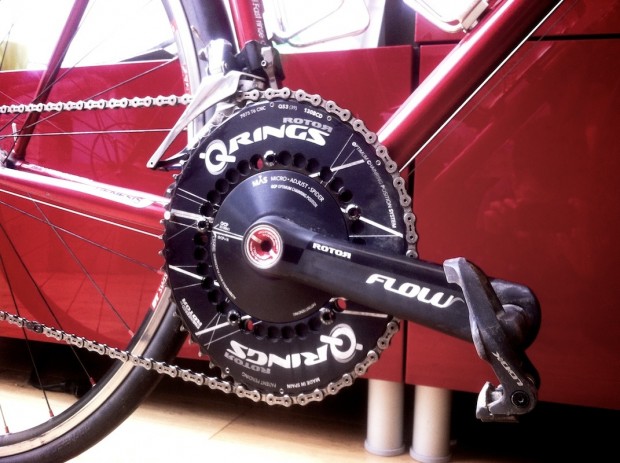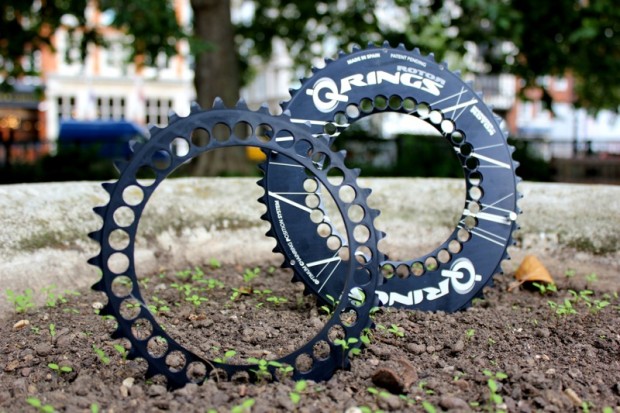We took a ‘first look’ last year at the Rotor Flow crank and, after months of testing, can report our findings.
Rotor’s UK distributor supplied us with a BSA 30 bottom bracket, which fitted to the classically-shaped RCUK Test Rig (a Genesis Equilibrium fashioned from Reynolds 725 tubing).
In fact, the fitting stage was the most complex part of the modern oval rings’ life with RCUK. While the Spanish and English instructions are great for the exploded diagrams, the fitting instructions left a little to the imagination and experience of the mechanic. If you are at all unsure then do enlist the help of your IBD, who will doubtless lend a helping hand.

Once on, however, and set up with the Q-Rings in position three, otherwise known as “standard road mode”, I was ready to start the first of the recommended four-phase acclimatisation program, as outlined by the guys at Rotor.
Phase one is all about the brain becoming used to the oval rings’ change in leverage through the stroke. This is probably the part where I should confess that I barely noticed the change initially. Recent power testing has shown that I have a pretty even wattage throughout the my pedal stroke. A few tests on Watt-bikes demonstrated a good circular stoke action already, prior to installing the Q-Ring setup. But this barely noticeable change became considerably more apparent at the end of the long rides I made as part of the phase two of the acclimatisation process. There was an additional circular flowing feeling to the pedaling motion, and even a very subtle push as the leg on the peak of the power stoke took the ‘dead’ leg over the usual weak point of the stroke. Interesting.
More miles in, and well into phase three, I noticed that even when pushing possibly a little too hard, it was easier to keep a smooth stroke, no choppiness rearing its energy-sapping head. Long, faster-paced rides where occasionally a more up and down pedaling action occurs near the end as fatigue sets in, seemed to become less frequent and certainly kept my cadence smooth and steady. I did experience a little extra fatigue post ride in the smaller inner leg muscles as they took on a little more work, but with stretching and more miles this has subsided.
Phase four completes the process and you are in theory then able to play about with the multitude of rotational positions of the Q-Rings to tweak the power curve to suit your riding style. I had not experienced any knee pain on the either the front or back of the leg so left the rings in the standard position. Other users my not be so ‘average’ and it is recommended to correct the alignment of the rings to alleviate any discomfort in the knee area even during the earlier acclimatisation phases. Do watch out for this issue.

So, what about the marginal gains as a result of using this updated version of BioPace? Well, a few of the local hills have seen me trialling the traditional ring setup in comparison to the Q-Rings and I can confirm a slight increase in power with the oval rings. A normal seated average of 350 watts up a steady road climb was increased up to 358 watts with a slight time reduction as a result. It’s obviously not wholly scientific at the moment, as I have not done sufficient riding over identical terrain in identical conditions, but at the moment I can report a small gain in wattage, and a drop in average heart rate in comparison to the same time last year. A better season? Or a bit of science working?
Q-Rings aside, I have also been impressed with the flow cranks. They are not an obvious aesthetic match for the Test Rig’s classical lines, and would look considerably more at home on the Cervelo P and S series machines of the Garmin-Sharp team.
However, they are admirably stiff and light. While the centre of the crank arms has been drilled and material deemed superfluous removed, they did not flex. The low profile appearance and nicely-machined finishing proved easy on the eye, and if it wasn’t for the slightly fiddly setup, these cranks, bottom bracket and rings would have been a total pleasure to test. As it is, huge credit to Rotor for essentially re-inventing the wheel. I think I am converted after all these months, but please – work on those instructions!





